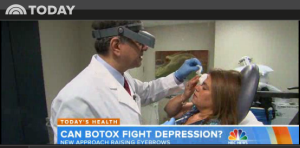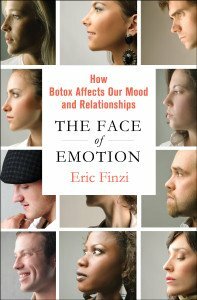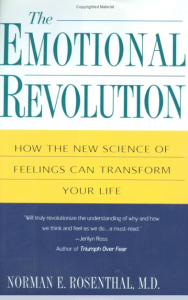While Botox is commonly used for cosmetic purposes, doctors say the reasoning behind the treatment for depression may not be what you expect.
“We don’t believe it has anything to do with looks,” says researcher Dr. Eric Finzi of Chevy Chase Cosmetic Center.
Rather, he says it’s because facial expressions are part of the circuit of the brain related to mood.

 Dr. Eric Finzi will be a guest on NPR Boston’s The Colin McEnroe Radio Show today at approximately 1:06PM EST talking about the Botox for Depression research study findings published in the Journal of Psychiatric Research (May 2014). The study “Treatment of Depression with onabotulinumtoxinA: A Randomized Double-Blind, Placebo Controlled Trial” found that 52% of subjects suffering from moderate to severe depression showed a relief from depression after injection of botulinum toxin to the glabellar area between the eyes, compared with only 15% of those who received the saline placebo. A second phase to this study is in the works.
Dr. Eric Finzi will be a guest on NPR Boston’s The Colin McEnroe Radio Show today at approximately 1:06PM EST talking about the Botox for Depression research study findings published in the Journal of Psychiatric Research (May 2014). The study “Treatment of Depression with onabotulinumtoxinA: A Randomized Double-Blind, Placebo Controlled Trial” found that 52% of subjects suffering from moderate to severe depression showed a relief from depression after injection of botulinum toxin to the glabellar area between the eyes, compared with only 15% of those who received the saline placebo. A second phase to this study is in the works.



 Another reason why Finzi’s idea appealed to me so much is that over a decade before he approached me, I had written a book about the science of emotion, called The Emotional Revolution. In it I wrote:
Another reason why Finzi’s idea appealed to me so much is that over a decade before he approached me, I had written a book about the science of emotion, called The Emotional Revolution. In it I wrote: It was highly plausible to me that frowning might send signals to the brain via different cranial nerves – the facial and trigeminal nerves. But in this case, it seemed, the signals aggravated a person’s mood rather than relieving it. So it made all the sense in the world to me that blocking these signals might reverse depression.
It was highly plausible to me that frowning might send signals to the brain via different cranial nerves – the facial and trigeminal nerves. But in this case, it seemed, the signals aggravated a person’s mood rather than relieving it. So it made all the sense in the world to me that blocking these signals might reverse depression. As a psychiatrist who has treated many people with depression, I am truly excited at this new treatment option. Although there are many available treatments for this very painful affliction, they are often only partially effective and have troublesome side-effects. I am delighted that we now have a new treatment option which can be used safely alongside all other treatments (as the Botox acts only locally in the muscles and is not absorbed). In addition, when properly administered by a trained person, Botox has few if any side-effects. So, what’s the catch?
As a psychiatrist who has treated many people with depression, I am truly excited at this new treatment option. Although there are many available treatments for this very painful affliction, they are often only partially effective and have troublesome side-effects. I am delighted that we now have a new treatment option which can be used safely alongside all other treatments (as the Botox acts only locally in the muscles and is not absorbed). In addition, when properly administered by a trained person, Botox has few if any side-effects. So, what’s the catch?